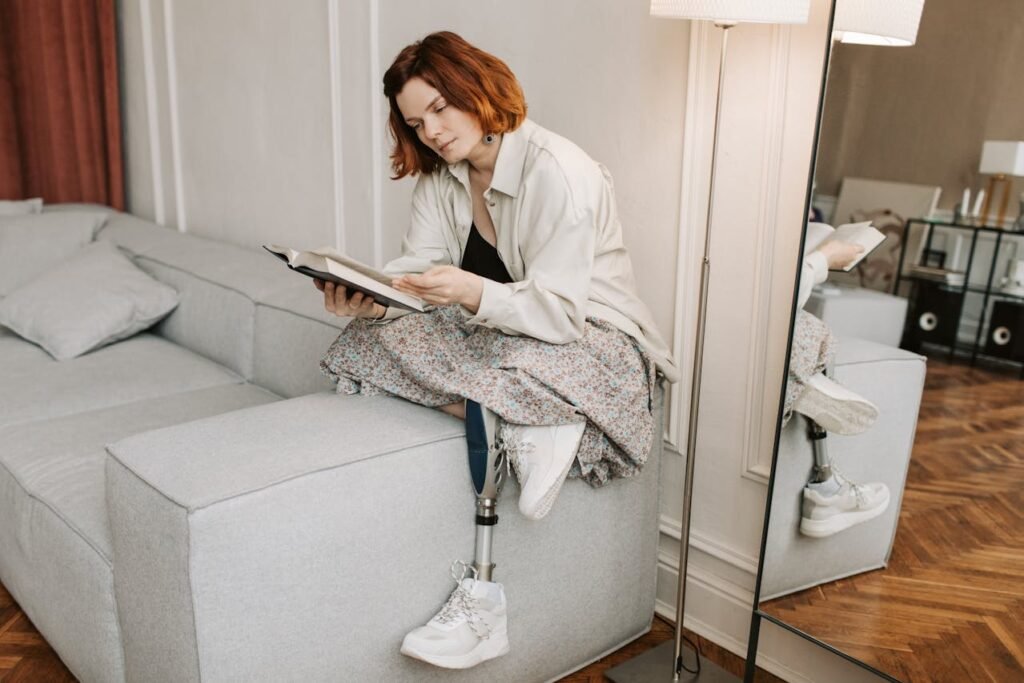Every prosthesis tells a story of strength. For women who use upper-limb prosthetics, the journey doesn’t end after fitting—it continues through care, maintenance, and mindful budgeting. These quiet, consistent efforts keep your prosthesis comfortable, functional, and ready for every part of daily life.
Yet, one of the most overlooked parts of this journey is planning ahead—understanding what needs to be replaced, what must be maintained, and how much it all costs over time. For many women balancing homes, jobs, and families, financial planning for prosthetic upkeep often takes a back seat. But the truth is, a little preparation today saves bigger expenses tomorrow.
At RoboBionics, we’ve met women from every corner of India—teachers, mothers, students, entrepreneurs—each managing their prosthetic in their own way. Some clean and store it with precision every night, while others juggle so much that care becomes occasional. Through their experiences, one lesson stands clear: maintenance is not just a technical task—it’s self-care.
This guide is built around that idea. You’ll learn how to plan your prosthetic’s yearly maintenance, understand the role of liners and gloves, and build a realistic budget that keeps you worry-free. Whether you’re using a myoelectric hand like Grippy or a mechanical design, this article will help you organize, prepare, and protect your investment—with the confidence that comes from knowledge.
Understanding Annual Prosthetic Maintenance
Why Regular Maintenance Matters

A prosthetic limb is much like a trusted companion—it helps you move, work, and live independently every single day. But just like any device that works hard, it needs care. Regular maintenance keeps it performing well and prevents sudden breakdowns.
For women using prosthetics daily, maintenance means comfort and reliability. Small cracks, loose parts, or friction areas can appear slowly. Left unchecked, they can cause discomfort or even damage your skin. With a simple maintenance schedule, you can avoid both pain and expensive repairs.
Think of annual maintenance not as a chore, but as a yearly health check for your prosthesis. A few hours of attention can add years of smooth use.
What a Standard Maintenance Check Includes
A good prosthetic clinic checks everything from joints and sockets to sensors and grips. For myoelectric devices like the Grippy Bionic Hand, this includes testing electrical connections, recalibrating the control system, and checking battery performance.
For mechanical prosthetics, technicians inspect the hinges, tension cables, and sockets. They’ll tighten or replace small parts that wear out over time.
If you use liners or gloves, they’ll examine the fit and texture. These components often need replacement due to wear and sweat exposure. Regular inspection ensures your prosthesis continues to fit comfortably without irritation.
Signs It’s Time for a Check-Up
Your prosthesis will tell you when it needs care. You might notice stiffness in the joints, unusual sounds, reduced grip strength, or even slight discomfort while wearing it.
For women, especially those with sensitive skin, any redness or pressure marks around the socket area are signs to visit your prosthetist. A simple adjustment can prevent skin damage or infection.
Even if everything feels fine, schedule at least one maintenance visit every year. Prevention always costs less than repair.
Preparing for the Appointment
Before your appointment, note any issues you’ve noticed—looseness, uneven grip, or battery drain. Bring all parts of your prosthetic system, including liners, gloves, and chargers if applicable.
Wear your prosthesis to the appointment so the prosthetist can see how it moves during your daily routine. Be open about how you use it—whether for work, cooking, typing, or exercise. This helps them tailor the maintenance to your actual lifestyle.
A clear discussion ensures your prosthesis stays perfectly aligned with your needs.
Daily Care Habits That Extend Life
Cleaning After Use
Everyday hygiene is the simplest way to keep your prosthesis in great shape. After removing it, gently wipe the surface with a clean, damp cloth to remove sweat and dust.
Avoid submerging the device in water unless it’s waterproof. For electronic prosthetics, use a soft dry cloth or alcohol-free wipes for safe cleaning.
Always let it air dry before storing. Moisture trapped inside the socket can irritate your skin and reduce grip precision in myoelectric models.
Caring for the Socket Area
Your skin and the prosthesis socket share a close connection, so keeping both clean is crucial. Wash the area with mild soap and water daily. Dry completely before wearing the prosthesis again.
If you notice redness or itching, take a break and inspect the area. Sometimes, a liner that’s slightly out of place can cause friction. A small adjustment can restore comfort immediately.
For women, skin tends to be more sensitive, so choose fragrance-free soaps and gentle moisturizers. Avoid applying lotion just before wearing your prosthesis—it can make the skin slippery and reduce stability.
Safe Storage
How you store your prosthesis affects its durability. Always place it on a dry, stable surface away from direct sunlight. Heat and humidity can weaken materials or affect battery performance.
If you travel often, carry a soft cloth pouch or protective case. This prevents scratches and keeps the prosthesis clean.
For myoelectric hands, store the charger and cables neatly. Avoid tangling or bending wires, as this can damage connectors over time.
Handling with Care
Even durable prosthetics require gentle handling. Avoid dropping or knocking it against hard surfaces. If you’re using the Grippy Bionic Hand, handle liquids carefully to prevent moisture from entering the sensors.
When removing your prosthesis, use both hands when possible. This ensures you don’t twist or pull at the wrong angle, especially near the socket connection.
Treating your prosthesis with care every day means fewer surprises and smoother performance year after year.
The Role of Liners in Comfort and Protection
Understanding Liners
A liner is the soft, cushion-like layer that sits between your residual limb and the prosthetic socket. It protects your skin, reduces pressure, and ensures a snug fit.
Liners are especially important for women, as they help manage skin sensitivity and keep the prosthesis feeling comfortable during long wear. A good liner acts like a second skin—it moves naturally with your body.
They come in materials like silicone, gel, or thermoplastic elastomer, each offering different levels of comfort and flexibility. Your prosthetist helps you choose the right one based on your lifestyle and skin type.
Daily Liner Care
Cleaning your liner daily prevents odor, bacteria, and skin irritation. Wash it with mild soap and lukewarm water. Avoid using hot water—it can damage the material.
Rinse thoroughly to remove all soap residue, then dry with a clean towel. Air-drying overnight is best. Never use hairdryers or heaters, as they can cause warping.
If you sweat heavily, you might need to clean the liner twice a day during warmer months. Consistent hygiene keeps your prosthesis feeling fresh and secure.
When to Replace Liners
Even with perfect care, liners wear out over time. Signs that you need a replacement include cracks, thinning spots, or loss of elasticity. If your liner feels loose or causes chafing, it’s time to consult your prosthetist.
Most liners last between six months to a year, depending on use. For women who wear their prosthetic daily, budgeting for one or two replacements each year is practical.
Replacing liners on time prevents skin irritation and ensures the prosthesis fits like new.
Choosing the Right Liner for You
Women’s needs vary—some prefer softer liners for comfort, while others choose firmer ones for stability.
If you lead an active lifestyle or work long hours, a durable silicone liner offers better support. For sensitive skin, gel liners provide soothing comfort and reduce friction.
Don’t hesitate to test different materials before finalizing. What feels right in the clinic may change after a few weeks of daily use, so your feedback matters.
Your prosthetist can also suggest breathable liners that reduce sweating—especially useful in India’s humid climate.
Gloves: Function and Protection
The Purpose of Prosthetic Gloves

Prosthetic gloves serve two main roles—they protect the device and give it a more natural look. For women, they also add confidence, blending seamlessly with your personal style.
These gloves shield mechanical and myoelectric hands from dust, moisture, and wear. Without them, everyday exposure to dirt and sweat can shorten your prosthesis’s lifespan.
They also improve grip on certain surfaces. The outer material adds friction, making it easier to hold objects like mugs, phones, or utensils.
Material and Texture Choices
Prosthetic gloves are made from silicone, PVC, or polyurethane. Silicone feels soft and natural, while PVC is more affordable and easier to replace.
Choose one that suits your routine. If you cook or work around water, waterproof gloves are ideal. For office work, lightweight silicone models offer comfort without bulk.
Some women prefer colored gloves that match their wardrobe or personality rather than skin tone. It’s entirely your choice—your prosthesis should reflect you, not hide you.
Cleaning and Longevity
Clean your glove regularly with mild soap and water. Wipe it dry gently and store it in a cool, shaded place. Avoid using alcohol or harsh chemicals, as they can dull the surface.
A prosthetic glove usually lasts six months to a year, depending on use. If you notice tears, discoloration, or reduced flexibility, replace it immediately to prevent damage to the prosthetic beneath.
Budget for at least one or two replacements annually, depending on your activity level and climate.
When Gloves Need Adjustment
Sometimes, gloves loosen slightly or form small air pockets around the fingers. This can affect grip and precision.
If this happens, visit your prosthetist. They can refit or trim the glove for better alignment. Never try to force-fit or cut it yourself—it may damage delicate components of the prosthesis.
Your glove should feel snug, smooth, and flexible. A perfect fit not only looks better but helps your prosthetic function effortlessly.
Budget Planning for Annual Care
Why Financial Planning Matters
When most women think about prosthetics, the first concern is usually the cost of the device itself. But what often gets overlooked is the recurring expense—the small, regular costs that keep it functioning perfectly.
Liners, gloves, batteries, maintenance, and cleaning supplies may seem minor at first, but they add up over time. Budgeting for these ensures that your prosthesis remains comfortable and reliable without surprise expenses.
A well-thought-out annual plan allows you to enjoy your prosthesis without worrying about sudden repair costs or running out of essential accessories. It also gives peace of mind, knowing you’re prepared for any situation.
Estimating Your Yearly Costs
Your yearly budget depends on the type of prosthesis you use and how often you wear it. For example, myoelectric hands like Grippy may need battery checks and occasional part replacements, while mechanical prosthetics might need new cables or liners.
On average, women should plan for:
- One or two new liners per year
- One or two prosthetic gloves annually
- One full maintenance service visit
- Occasional cleaning products or accessories
These costs vary depending on brand and usage, but setting aside a small monthly amount—like a personal care fund—makes it manageable. It’s easier to save a little each month than face one large bill unexpectedly.
Understanding Warranty and Service Plans
Most prosthetic devices come with a warranty period covering manufacturing defects. However, regular wear-and-tear items like liners and gloves are usually not included.
When buying a prosthesis, ask your provider about service packages. Some offer annual maintenance plans at discounted rates, which include periodic check-ups and basic replacements.
These plans are excellent for budgeting—they fix costs upfront and help you avoid inflated prices later. If your clinic doesn’t have such an option, negotiate one. A transparent agreement builds trust and reduces financial stress.
Factoring in Lifestyle and Usage
A woman who works in an office setting might use her prosthesis differently from one who manages a household or runs a business. Your daily activities directly influence how quickly components wear out.
If you lead an active lifestyle—cooking, driving, or using your prosthesis for several hours daily—expect faster glove wear and more frequent liner replacements.
Budget accordingly for your rhythm of life. Understanding your personal usage helps you prioritize which items need saving for first. It’s not about spending more—it’s about spending wisely.
Planning for Upgrades
As technology advances, you may want to upgrade your prosthetic after a few years. Modern designs often bring better comfort, lighter materials, or new functions that make everyday tasks easier.
Saving a small amount annually toward potential upgrades helps when that time comes. Even if you don’t plan to change soon, having a small reserve gives you flexibility if a new, more efficient model becomes available.
Consider upgrades an investment in your independence, not a luxury. A prosthetic that fits your evolving needs improves quality of life every day.
Cost-Saving Tips for Women Prosthetic Users
Consistent Care Reduces Replacement
The simplest way to save money is through regular care. A well-maintained prosthesis lasts longer, functions better, and needs fewer repairs.
Cleaning your liners daily, storing your prosthesis properly, and visiting your prosthetist once a year keeps everything in good condition. Ignoring these can lead to faster wear and bigger bills.
Think of care as prevention. Small daily habits save large expenses later.
Reusing and Rotating Liners
If you own two liners, rotate them regularly. This gives each one time to dry completely and prevents bacteria buildup. Alternating also reduces friction, extending the life of both.
Rotating liners means you replace them less often, saving money while maintaining comfort. Just make sure both are cleaned properly after use.
If your prosthetist offers bulk discounts on liners or gloves, consider buying a set once a year—it’s often cheaper than purchasing individually later.
Avoiding Common Damage
Most damage happens accidentally—from dropping, overexposure to heat, or improper cleaning. Avoid storing your prosthesis in damp or sunny areas. Don’t use alcohol-based cleaners, as they weaken materials.
If you use a myoelectric device, keep liquids away from the sensors. Even a small spill can cause electronic issues. Handle your prosthesis as you would a delicate instrument—steady, clean, and secure.
When traveling, carry it in a padded case. One moment of protection saves you the cost of repair later.
Making Use of Government and NGO Programs
In India, several initiatives help women with disability-related expenses, including prosthetic maintenance and replacements. Some state welfare departments, charitable hospitals, and NGOs provide financial assistance or free check-ups.
Ask your prosthetist about these programs—they often have partnerships or awareness of available support. Keeping informed ensures you never miss benefits you’re entitled to.
You can also connect with local women’s support groups for information on community-based prosthetic services. Shared knowledge often opens new opportunities.
Planning with Your Prosthetist
A proactive conversation with your prosthetist can help you save intelligently. They can estimate when parts may need replacement, recommend affordable options, and even schedule reminders for upcoming checks.
A transparent relationship helps you plan your finances better. It’s not about cutting corners—it’s about working smartly together to keep your prosthesis in top condition at reasonable costs.
Long-Term Care for Durability and Comfort
Monitoring Your Skin Health

Healthy skin ensures a comfortable fit. For women, who may experience hormonal skin changes or sensitivity, daily skin care around the socket area is essential.
Use gentle, fragrance-free cleansers and moisturizers. If you notice persistent redness, rashes, or itching, consult your prosthetist immediately. They can adjust the liner or socket to relieve pressure points.
Healthy skin prevents infections that could require expensive medical treatment or prosthetic refitting. Simple daily care saves both discomfort and cost.
Keeping Batteries and Electronics Strong
For electronic prosthetics, battery maintenance is crucial. Avoid overcharging—disconnect once fully charged to extend battery life.
Clean the battery contacts occasionally with a dry, lint-free cloth. If you notice a decrease in charge duration, mention it during your annual check-up. Sometimes, calibration can fix it without replacement.
Proper charging habits save you the expense of early battery replacement and ensure consistent performance.
Seasonal Adjustments
India’s weather can be harsh—hot summers, humid monsoons, and cool winters all affect how your prosthesis behaves.
In summer, keep your prosthetic and liners dry to prevent moisture buildup. During winter, avoid exposing the device to extreme cold for long periods. Each season brings small adjustments that help extend your prosthesis’s lifespan.
Ask your prosthetist if specific cleaning or storage methods are recommended based on your region’s climate. These subtle changes make a big difference over time.
Storing Spare Parts and Supplies
Always keep essential backups—like an extra liner, glove, or cleaning cloth. Having spares on hand saves stress during emergencies and prevents skipping wear due to a missing part.
Store them properly in labeled containers or soft pouches. Keep them dry and away from sunlight to prevent material degradation.
Being prepared helps you avoid unplanned spending or interruptions in your daily routine.
Emotional Connection and Routine
Taking care of your prosthesis isn’t just maintenance—it’s a ritual of self-care. The few minutes you spend cleaning, inspecting, or organizing it reflect self-respect and discipline.
Many women describe it as grounding—a small act that restores confidence and control. When you care for your prosthesis regularly, it becomes part of your daily rhythm, not a burden.
This emotional connection motivates consistency, which ultimately saves time, money, and effort.
Practical Budgeting for Women Prosthetic Users
Creating a Simple Yearly Plan
Budgeting for your prosthesis doesn’t need complicated tools or spreadsheets. It starts with understanding your yearly needs and putting aside small amounts regularly.
A simple way is to divide your yearly care expenses into monthly savings. For example, if your annual prosthetic maintenance and replacements cost ₹12,000, setting aside ₹1,000 each month covers it easily.
This approach turns a big expense into a manageable habit. You can even set reminders in your phone or mark it on a calendar. Small, steady planning helps you stay financially ready without stress.
Breaking Down Your Annual Expenses
Your budget will depend on your prosthetic type and daily routine, but here’s a basic example for women using upper-limb prosthetics like the Grippy Bionic Hand.
Approximate yearly breakdown:
- Liners: ₹5,000–₹10,000 (1–2 replacements per year)
- Gloves: ₹3,000–₹6,000 (1–2 replacements)
- Maintenance service: ₹4,000–₹8,000 (including inspection and tuning)
- Cleaning products and accessories: ₹1,000–₹2,000
- Travel and consultation costs: ₹1,000–₹3,000
That totals around ₹15,000–₹25,000 annually. It might sound like a lot, but planned monthly, it’s about ₹1,500–₹2,000. Treat it like an investment in your comfort and independence.
Remember, every prosthetic has its rhythm. If you use yours lightly, your costs may be lower. What matters is consistency—not perfection.
Separating Prosthetic Funds from Household Budget
One common challenge women face is merging prosthetic expenses with household finances. Over time, these small costs disappear among groceries, travel, or family needs.
To avoid this, maintain a small personal care fund—either a separate savings account or even a labeled envelope system. Add to it monthly, even if it’s a small amount.
When the time comes for maintenance or replacements, you won’t need to borrow or delay care. It’s a practical way to stay independent and financially prepared.
Planning for Emergencies
Sometimes, unexpected repairs happen—a sudden break, battery issue, or damaged liner. Having a small emergency cushion helps you handle it calmly.
Keep an extra ₹2,000–₹3,000 aside each year for such situations. If you don’t use it, roll it forward into next year’s maintenance budget.
This small buffer ensures your prosthesis never stays idle because of financial delay. It’s peace of mind stored safely in a small fund.
Considering Insurance and Reimbursement
In India, health insurance rarely covers prosthetic maintenance, but policies are slowly improving. Some private plans now include partial coverage for assistive devices.
Check your policy or talk to your insurance agent about available options. If not directly covered, you can request medical reimbursement for repairs or fittings under wellness claims.
Your prosthetist can also guide you toward local programs, NGOs, or government initiatives that subsidize prosthetic accessories for women. Staying informed saves not just money—but also time.
Women-Specific Financial Planning
Managing Costs Around Life Changes

Women’s lives often shift between roles—career, family, caregiving, and personal growth. Each stage brings changes in how and when you use your prosthesis.
For instance, during pregnancy or hormonal changes, body size and comfort levels may fluctuate. In such times, budget a little more for liners or socket adjustments.
If you’re resuming work after a break or changing professions, reassess your prosthetic’s needs. Budget for new gloves or maintenance to ensure it keeps up with your daily pace.
Planning around these natural transitions makes your prosthetic care sustainable and stress-free.
Prioritizing Comfort Within Budget
Budgeting doesn’t mean choosing the cheapest option—it means choosing what gives the most value and comfort for your lifestyle.
Sometimes, investing in a higher-quality liner or glove pays off long-term because it lasts longer and feels better. Avoid unnecessary cuts that lead to discomfort or frequent replacements.
Think of every expense as a partnership between function and feeling. You’re not just maintaining a device—you’re nurturing your independence.
Involving Family in Planning
Many women hesitate to discuss prosthetic-related costs with family, fearing it may sound like a burden. But open conversations can build understanding and support.
Share your yearly maintenance plan clearly. When family members understand its importance, they’ll see it as part of your well-being, not an extra expense.
It also helps when emergencies arise—your loved ones will know why immediate care or adjustments matter. Inclusion brings peace, and peace brings confidence.
Empowering Yourself Financially
Financial independence doesn’t always mean earning more—it’s about managing wisely. Setting a clear prosthetic care budget puts you in control.
Women often prioritize everyone else’s needs first. But this budget is yours—dedicated to your comfort, health, and movement.
By caring for your prosthesis and planning its costs, you’re giving yourself the same respect and attention you give others. That’s empowerment in action.
Emotional Empowerment Through Ownership
The Mindset of Care
Caring for your prosthesis is not just maintenance—it’s part of self-love. It shows that you value your body, your freedom, and your comfort.
Women who build steady care routines often describe a sense of calm that comes from knowing they’re in control. It’s not about perfection—it’s about progress, one small step at a time.
That simple act of budgeting each month and cleaning daily turns your prosthetic journey into a story of quiet strength.
Building Routine and Confidence
Routine creates ease. When you already know when to clean, when to schedule maintenance, and when to replace parts, everything feels lighter.
Confidence comes naturally when your prosthesis works flawlessly. It allows you to focus on life, not worry about breakdowns or discomfort.
This comfort isn’t built overnight—it’s built with every little act of care, repeated patiently.
Overcoming the Fear of Expense
Many women feel anxious about the long-term costs of prosthetics, especially when managing multiple responsibilities. But planning replaces fear with control.
When you break down costs into small, regular steps, the number feels less daunting. It becomes achievable.
You’re not facing a large, unpredictable expense—you’re simply managing an ongoing part of your life with grace.
Self-Worth Beyond Budget
Your prosthesis is a symbol of resilience, not a financial weight. Investing time and care in it is a way of investing in yourself.
When you look at your maintenance schedule, don’t see expenses—see empowerment. Every rupee you spend helps you move freely, work confidently, and live independently.
You deserve that ease. You’ve earned it through every challenge you’ve faced and every step you’ve taken since.
Real-World Budgeting Examples
Example 1: Meera, 28, Corporate Professional
Meera uses her Grippy Bionic Hand daily for typing, cooking, and commuting. Her annual care budget looks like this:
- Liners: ₹8,000
- Gloves: ₹4,000
- Maintenance: ₹6,000
- Miscellaneous cleaning and travel: ₹2,000
She saves ₹1,700 every month in a separate account. When her prosthetist calls for her yearly check, she already has enough saved without touching her salary.
This simple plan keeps her prosthetic care effortless and stress-free.
Example 2: Kavita, 35, Homemaker
Kavita uses a mechanical prosthetic hand for home chores and occasional outdoor work. Her costs are lower but still planned carefully.
- Liner replacement: ₹5,000
- Glove: ₹3,000
- Annual tune-up: ₹4,000
She sets aside ₹1,000 monthly from her household budget. Her husband and children know about it and remind her to book her check-ups on time.
This shared awareness makes her feel supported and respected in her care routine.
Example 3: Sana, 40, Small Business Owner
Sana travels often for work, so her prosthesis faces heavy use. She budgets more for protective gloves and spares.
- Two gloves annually: ₹6,000
- Two liners: ₹10,000
- Service plan: ₹8,000
She keeps ₹2,000 monthly aside and uses digital wallets to track her spending. Whenever she gets a business bonus, she adds it to her prosthetic fund.
By treating it as a regular business expense, Sana never feels financially pressured when maintenance time arrives.
The Common Thread
Whether you’re a professional, homemaker, or entrepreneur, budgeting gives you stability. It ensures your prosthesis never becomes a financial surprise.
What connects all these women is not income—it’s intention. They plan, prepare, and prioritize comfort.
That mindset transforms prosthetic care from responsibility into empowerment.
Closing Thoughts
Your prosthesis deserves care—not because it’s fragile, but because it supports your strength every day.
Maintenance, liners, and gloves are not extra costs—they are parts of your comfort, safety, and independence.
Budgeting for them gives you freedom. It frees your mind from worry and helps you move through life with confidence and ease.
At RoboBionics, we design every prosthetic with long-term comfort and affordability in mind. Our Grippy Bionic Hand and Mech series are built for women who balance life beautifully—strong, graceful, and unstoppable.
If you’d like to explore your options or learn how to care for your prosthesis better, book a free demo or consultation at www.robobionics.in/bookdemo.
Because every woman deserves a prosthesis that feels like her own—easy to care for, affordable to maintain, and made to move with her, every single day.



